PeRsiMMoN
two ways
steam pudding with sliced fuyu and chantilly cream flavored with brandy
verrine layered with hachiya pulp, steam pudding, chantilly cream
hachiya & fuyu
Hachiya is heart-shaped. Fuyu is tomato-shaped. And the differences don’t end there.
The hachiya must be completely ripe to be palatable, or else the taste is astringent and off-putting, reminiscent of chalk. But when it is ripe it is sublime – a not-too-sweet apricot-like flavor, with a hint of honey, and unique slippery texture. The fuyu – on the other hand – can be eaten like an apple, diced for a salad or salsa, or sliced into wedges when it is softer and served with dessert or cheese. Persimmon has the pizzazzy flavor of Fall!
A ripe heart-shaped hachiya…
Is gooey. Cut open in a bowl with a knife.
Spoon the pulp into verrines.
Top the persimmon pulp with steam pudding, chantilly cream, and mint.
Hachiya Steam Pudding
Sally made this steam pudding by combining 1 c. sugar with 1/2 c. melted butter then added 1 c. flour sifted with 1 t. cinnamon, 1/4 t. nutmeg, and 2 t. baking soda. Then she added 1 c. hachiya persimmon pulp, 1 t. vanilla, 3 T. Grand Marnier, 2 eggs, 1 c. raisins and 1/2 c. walnuts. Mixed lightly but thoroughly.
She filled a roasting pan with enough water to reach half-way up the sides of a Bundt pan and brought the water to a boil.
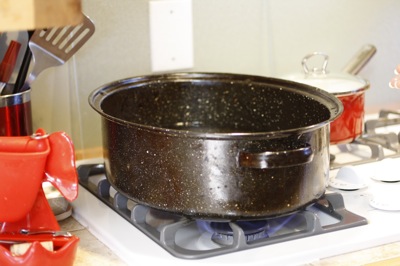
This covered roasting pan by Granite Ware has been in Sally’s family for almost 100 years. The same company has been making these black enamel-on-steel roasters, specked with white flecks, since 1871.
She greased the mold with cooking spray, poured in the batter, and placed it into the hot water. She covered the roaster with its tight-fitting lid, and steamed the pudding over low heat for 2 1/2 hours – then let it cool slightly before un-molding onto a serving platter.
Fuyu Persimmon
The tomato-shaped fuyu – slightly soft, cut into wedges.
A slice of very moist hachiya persimmon steam pudding, sliced fuyu, and chantilly cream flavored with brandy, and a glass of milk – a dessert for persimmon lovers! Persimmons are in season here October through December only and we are certainly enjoying the season! Sally, Alice, and I still have more persimmons, ripening daily. Today I will be trying a sorbet recipe. And persimmon fans might also enjoy the bread pudding with bourbon creme anglaise posted earlier in the week here.
PROJECT FOOD BLOG
Winner Announced on December 17.
Please join me in congratulating Jen Che, of Tiny Urban Kitchen blog
as the winner of Project Food Blog 2010.
I am a huge fan, congrats Jen! Well-deserved indeed.
If you haven’t already, be sure to read Jen’s impressive entry for Challenge # 10: The Final Post here.
And thank you all, one last time, for your support of Taste With The Eyes in the competition!


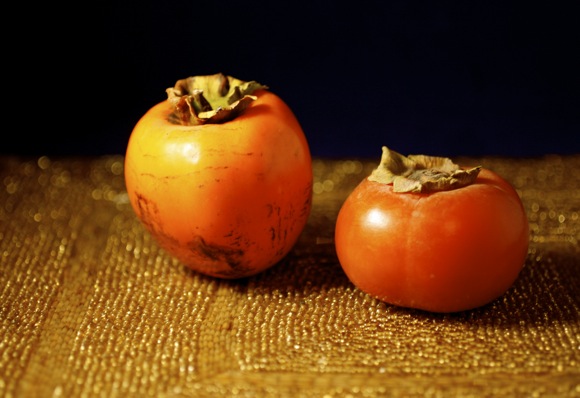
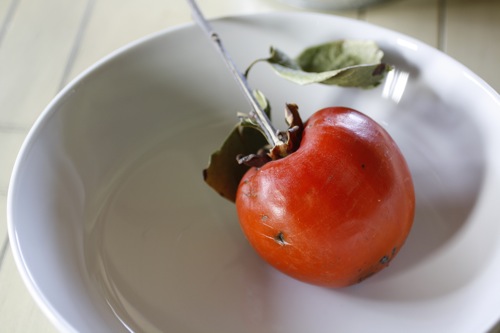
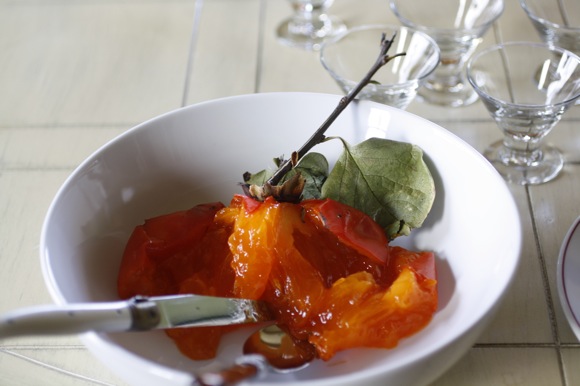
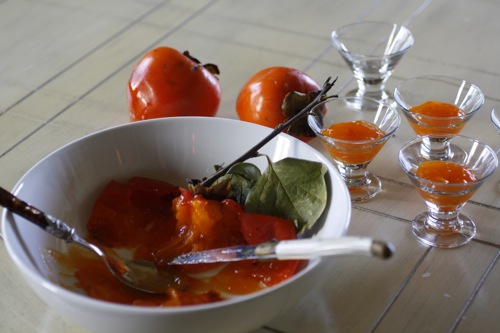

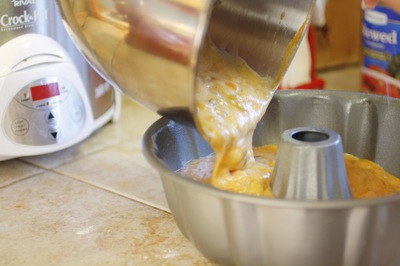

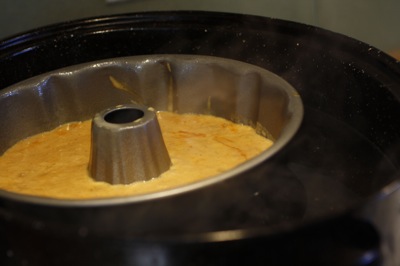
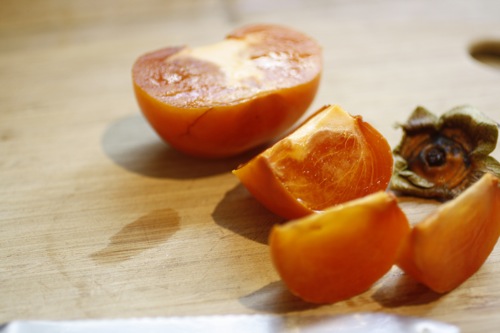
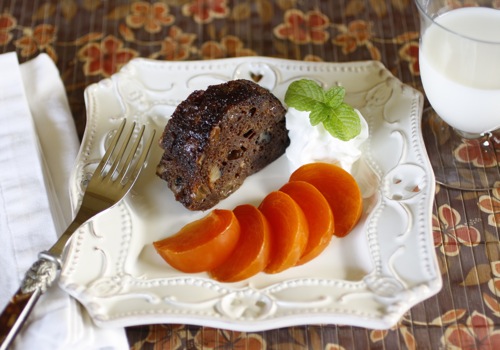


This looks lovely. I recently tried persimmon for the first time. I must have had an unripe one because I felt like it sucked my inside out. Now I know what it is supposed to taste like. How do you know when it’s ripe?
Hi Joan – the hachiya will be super-soft, like jell-o. I think someone described it as feeling like you are holding a water balloon. They are not sold ripe in the store because they are very fragile when ready to eat, the skin splits, the pulp starts oozing out, and it’s pretty messy. If you see a hachiya at the market, take it home, and wait…
LL
Wow…what a lovely post. Your photography is just beautiful. I found myself transported with each and every shot. I have only cooked/baked with persimoons a few times, but I find the flavor to be irresistible, and I’m always excited to find new recipes that utilize the winter fruit. Thank you for sharing with me, my dear!
Thank you for sharing the differences in taste and texture of the hachiya & fuyu. It’s a wonder it’s named the same fruit, but that the varieties are so different otherwise.
Luv those mini desserts, they look so elegant and inviting.
Your persimmon desserts are gorgeous! I just baked w/ fuyus for the first time a few days ago and now I’m even more inspired by your creations. It’s funny, I’ve always had a hard time describing the flavor of persimmons but we described them the same way: honey-like. It’s true, isn’t it? I’d like to try these before persimmon season is behind us. Thanks!
Name of your blog is just right..I can almost taste this through my eyes..So beautiful as always!
well done, this looks wonderful… I never use persimmon but you’ve inspired me :))
You’re pictures are amazing! And the dessert sounds sooo good!
Just lovely.
I’ve been testing new recipes with persimmon for the last couple of weeks. They are so, so special! Your recipes are beautiful and delicious and so are your photos!
Mmmm – I love persimmon. I had no idea there was so much difference between the two types. I would also hav binned the pulpy one thinking it was way over ripe. So very wrong ! I’m glad I now know the difference….
Two absolutely gorgeous desserts that are so festive and perfect for the holidays! I recently baked muffins with Fuyu persimmons and mentioned the two varieties in my post, next I’ll have to try Hachiya’s – thanks for the wonderful description of their taste differences.
I like both hachiya and fuyu…your desserts are stunning. Congrats on foodbuzz top 9!!
I’ve never had haciya or fuyu persimmons, so I can only stare at these in awe of the flavors they must yield. I saw this on the top 9 so I had to come over and check it out for myself!
Neither fuyu or persimmons or haciya are accessible here. More’s the pity. This is when I wish I lived in L.A. (and I’ll take your rain over my snow). I wonder if they’ll show up in the warmer months. Stunning, welcoming post as usual. If I cannot find the ingredients, I can at least “taste with the eyes.”
I miss the wild native persimmons we had back in the Midwest, but I’ve learned that hachiya pulp is almost as good in an Indiana-style persimmon pudding. This year I tried an upside-down cake with sliced fuyus as the topping fruit, cooked in butter and brown sugar in the usual way, with the pudding batter poured over. The mixture had too much moisture to come together as neatly as I wanted, but after a week or so of aging in the fridge we could slice it and put it into bowls, where we topped it with whipped cream. I’ll try a variation on that next season, with a more cake-like batter and some less-ripe fuyus.
Your dessert, in all its guises, looks truly lovely. I think next year we need to explore more possibilities with the fuyus, using them as we’d use stone fruits, for instance.